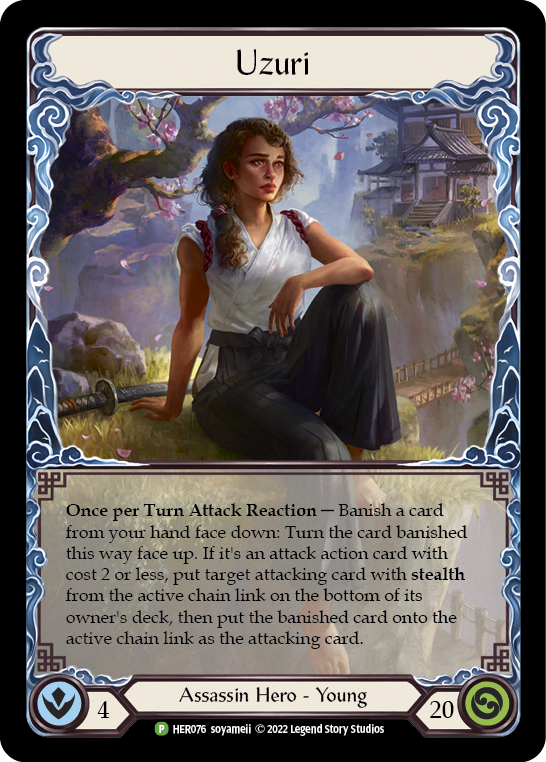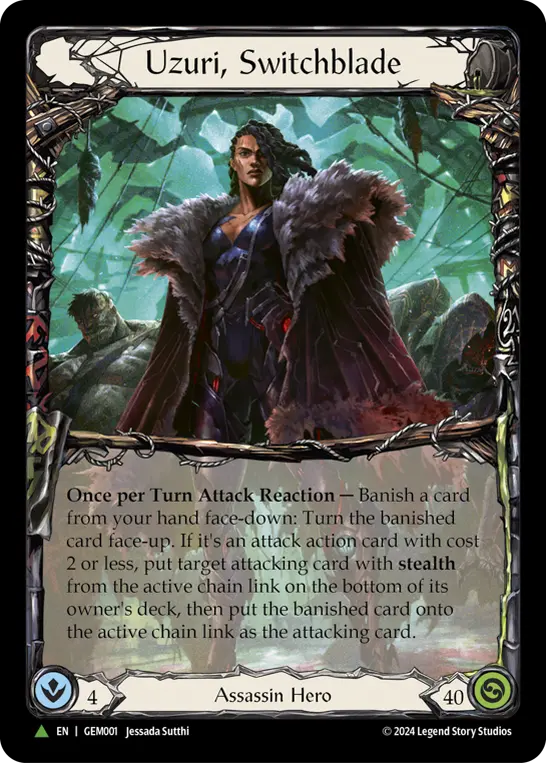

Re-Examining Riptide sent me down a rabbit hole with Outsiders that arrived at the doorstep of the gang boss Uzuri. This Assassin has fascinated a segment of my local play group, and as such I've spent little time with her myself - my personal gaming values demand that I contribute to a fun and diverse environment by avoiding intentional replication. But after attempts to build Arakni failed to give me a decklist that I could both be successful with and enjoy, my eyes turned back to Uzuri. If I must run the same hero, how can I run her differently?
Commanding Presence
To iterate on a deck with any kind of success, you have to first identify what makes the deck successful. In the case of Uzuri, that success in found in 2-card hands that, essentially, get to assess most of your opponent's blocking plans before committing to the attack. Under usual gameplay, a hero would pitch a card to play Command and Conquer; Uzuri, instead, plays out the pitch card (provided it has stealth) as a placeholder for the attack, and waits to see if the opponent will respond in a fashion that's desirable for us. If we don't like the outcome it looks like we'll have, we can simply let the stealth attack resolve without swapping in our C&C. That card can either go in our arsenal to play out conventionally next turn, or stay in our hand to attempt to swap in again.


This gameplay allows us to conserve our very best cards for maximum impact, getting around half of the hidden information in a typical combat cycle. While the quantity of our key cards isn't changed, the quality of the situations where they're played out is essentially ensured.
But this tricky gameplay becomes relatively predictable due to the firm role of math in this game. Uzuri's swapped-in attack can't cost more than 2, which means it's not really capable of dealing more than 6 if we want to also punish them with an on-hit effect. With this knowledge, opponents can simply treat each stealth attack as if it were a 6 and block accordingly. It's strategic adaptation we've been accustomed to since Welcome to Rathe introduced the game with Dorinthea as one of four initial offerings.
Which got me thinking: how can we add some of Dorinthea's gameplay to Uzuri?
Switchblade
The Assassin card pool is full of attack reactions; and because the class, on the whole, lacks consistent access to go again, these attack reactions become the only way to make full use of larger hands.


But while many of the best candidates for Uzuri's attack-shifting ability are generics like Command and Conquer, Amnesia, and Humble, the attack reactions are often limited to Assassin-class attacks. The vast majority of our qualifying attacks, therefore, are the opening stealth attacks. Building in a strong core of reactions, therefore, pivots Uzuri toward a Warrior style of play: the stealth attack we present is only a base upon which we'll build stats and even on-hit effects afterwards.
By leaning into this segment of the class, I found a fresh sense of unpredictability that disrupted the rote gameplay many had learned for dealing with Uzuri. Consider the following hand:




To make the whole thing more interesting, let's say I also have a blue Wither in my arsenal from last turn, and I open by playing that out. My turn can now take any of the following paths:
Wither for 1 > Uzuri swaps Wither for Ravenous Rabble for 5 with go again > pitch Wither to play Humble for 6 > react to their blocks with Spreading Plague
Wither for 1 > Uzuri swaps Wither for Ravenous Rabble for 5 with go again > pitch Wither to play Humble for 6 > arsenal Spreading Plague
Wither for 1 > pitch Wither, react to their blocks with Spreading Plague > break Snapdragon Scalers for go again > Ravenous Rabble for (5 - topdeck) > play Humble for 6
Wither for 1 > Uzuri swaps Wither for Humble for 6 > pitch Ravenous Rabble to react to their blocks with Spreading Plague > arsenal Wither for next turn
Each of these playlines is an ideal answer for a particular response from your opponent - and this flexibility and unpredictability ensures that your opponent can't learn your play patterns and simply respond optimally no matter what secrets you're hiding. More importantly, it answers one of Uzuri's most glaring weaknesses: the inability to effectively use 4-card hands when they happen.
But the added variety of card roles does open you up to issues of consistency. To adapt, an Uzuri incorporating a higher reaction count needs to be comfortable with blocking out when they've got a bad hand - and tanking damage when they've got a great one.
Something to Get You Started

Weapons
- Orbitoclast (1)
- Nerve Scalpel (1)
- Spider's Bite (1)
Equipment
- Flick Knives (1)
- Fyendal's Spring Tunic (1)
- Snapdragon Scalers (1)
- Nullrune Hood (1)
- Mask of Malicious Manifestations (1)
Loadout
- Frailty Trap (Red) (2)
- Firebreathing (Red) (2)
- Isolate (Yellow) (2)
- Isolate (Blue) (2)
- Back Stab (Red) (2)
- Razor Reflex (Red) (2)
- Shred (Yellow) (2)
- Death Touch (Red) (2)
- Isolate (Red) (2)
- Humble (Red) (2)
- Command and Conquer (Red) (2)
- Sink Below (Red) (2)
- Infiltrate (Red) (2)
- Infect (Blue) (2)
- Shake Down (Red) (2)
- Spreading Plague (Yellow) (2)
- Sneak Attack (Red) (2)
- Virulent Touch (Blue) (2)
- Ravenous Rabble (Red) (2)
- Spike with Bloodrot (Red) (2)
- Spike with Frailty (Red) (2)
- Wither (Blue) (2)
My development with Uzuri is still very much ongoing, but I wanted to give you a decklist to illustrate the concept and give you a chance to feel it in action. Still very much working with the successful core of the top performing lists, this Blitz build dedicates 25% of its presented deck to attack reactions. The effects of these reactions include attack and defense modifiers, disease tokens, and go again; they answer situations where the stealth attack is your primary attack, help swapped in attacks to climb over defenses, and make your opponent pay for heavily blocking you out.
I spoke above about my concerns with unusable cards in full hands, which only becomes magnified in the late game when you hit a pitch cycle primarily comprised of your swapped-out stealth attacks. To manage this, I've included two copies of Firebreathing, which can easily reach 9 attack in a hand drowning in blues. (It's also a 3-block, so if the game is moving faster than anticipated, feel free to defend with it.)

This list is very customizable, so add your own touches and adjust it to suit your style and your local meta. In fact, Uzuri's deception is well served by regular deck changes; I'd encourage you to regularly trade out cards to keep repeat opponents guessing! This is a decklist best built 10 cards over, with the extras left at home before each event. A spicy single red Pummel, for example, could shake up your scene one week, while the next week you might shift to a heavier representation of go again in your swap-ins.
Return to the Pits
This unintended re-focus on Outsiders has got me really excited about a set that the meta quickly moved past - and I really encourage you to revisit the decks you've passed up as well! (Perhaps next week I need to discuss a Ninja?) But while I turned a blind eye to Riptide largely due to my preference for other Rangers, Uzuri was a victim of my deference to the mainstream. I saw what was working, didn't enjoy it myself, and moved on. Going back now with an eye toward experimentation, I found a direction that spoke to me personally; and while I won't personally be taking Uzuri to my next major event, I'm now able to make use of a neglected portion of my collection during Armory events.
You've got 1 more week before the denizens of the Pits once more get pushed to the shadows in favor of Metrix. Why not try something novel?




